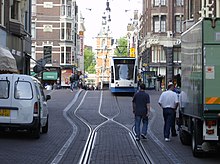
Back حضرية جديدة Arabic Новы урбанізм Byelorussian Nový urbanismus Czech New Urbanism Danish New Urbanism German Νέα αστικοποίηση Greek Nuevo urbanismo Spanish Uus-urbanism Estonian نوشهرگرایی Persian Uusi urbanismi Finnish

New Urbanism is an urban design movement that promotes environmentally friendly habits by creating walkable neighbourhoods containing a wide range of housing and job types. It arose in the United States in the early 1980s, and has gradually influenced many aspects of real estate development, urban planning, and municipal land-use strategies. New Urbanism attempts to address the ills associated with urban sprawl and post-Second World War suburban development.[1][2][3][4][5][6][7][8][9]
New Urbanism is strongly influenced by urban design practices that were prominent until the rise of the automobile prior to World War II; it encompasses ten basic principles such as traditional neighborhood development (TND) and transit-oriented development (TOD).[10] These ideas can all be circled back to two concepts: building a sense of community and the development of ecological practices.[11]

The organizing body for New Urbanism is the Congress for the New Urbanism, founded in 1993. Its foundational text is the Charter of the New Urbanism, which begins:
We advocate the restructuring of public policy and development practices to support the following principles: neighborhoods should be diverse in use and population; communities should be designed for the pedestrian and transit as well as the car; cities and towns should be shaped by physically defined and universally accessible public spaces and community institutions; urban places should be framed by architecture and landscape design that celebrate local history, climate, ecology, and building practice.[12]
New Urbanists support regional planning for open space; context-appropriate architecture and planning; adequate provision of infrastructure such as sporting facilities, libraries and community centres;[13] and the balanced development of jobs and housing. They believe their strategies can reduce traffic congestion by encouraging the population to ride bikes, walk, or take the train. They also hope to increase the supply of affordable housing and rein in suburban sprawl. The Charter of the New Urbanism also covers issues such as historic preservation, safe streets, green building, and the redevelopment of brownfield land.[14] The ten Principles of Intelligent Urbanism also phrase guidelines for New Urbanist approaches.
Architecturally, New Urbanist developments are often accompanied by New Classical, postmodern, or vernacular styles, although that is not always the case. The movement's principles are reflected in the field of Complementary architecture.
- ^ Trudeau, Dan (2013). "New Urbanism as Sustainable Development?". Geography Compass. 7 (6): 435–448. Bibcode:2013GComp...7..435T. doi:10.1111/gec3.12042.
- ^ Anderson, Matthew B. (2017). "New Urbanism". International Encyclopedia of Geography: People, the Earth, Environment and Technology: 1–3. doi:10.1002/9781118786352.wbieg0016. ISBN 978-0-470-65963-2.
- ^ Trudeau, Dan (2019). "New Urbanism". The Wiley Blackwell Encyclopedia of Urban and Regional Studies: 1–10. doi:10.1002/9781118568446.eurs0223. ISBN 978-1-118-56845-3.
- ^ Łucka, Daria (2018). "How to build a community. New Urbanism and its critics". Urban Development Issues. 59 (1): 17–26. doi:10.2478/udi-2018-0025.
- ^ Caves, R. W. (2004). Encyclopedia of the City. Routledge. pp. 491. ISBN 9780415252256.
- ^ Garde, Ajay (2020). "New Urbanism: Past, Present, and Future". Urban Planning. 5 (4): 453–463. doi:10.17645/up.v5i4.3478.
- ^ Moore, Susan; Trudeau, Dan (2020). "New Urbanism: From Exception to Norm—The Evolution of a Global Movement". Urban Planning. 5 (4): 384–387. doi:10.17645/up.v5i4.3910.
- ^ Grant, Jill L. (2015). "New Urbanism". International Encyclopedia of the Social & Behavioral Sciences (Second Edition): 809–814. doi:10.1016/B978-0-08-097086-8.74021-9. ISBN 9780080970875.
- ^ McCann, Eugene (2020). "Urbanism, New". International Encyclopedia of Human Geography (Second Edition): 135–140. doi:10.1016/B978-0-08-102295-5.10299-9. ISBN 9780081022962. S2CID 242405833.
- ^ Kelbaugh, Douglas S. 2002. Repairing the American Metropolis: Common Place Revisited. Seattle: University of Washington Press. 161.
- ^ "Urbanism Principles". www.newurbanism.org. Retrieved 20 January 2016.
- ^ "The Charter of the New Urbanism". 20 April 2015.
- ^ Wear, Andrew (16 February 2016). "Planning, Funding and Delivering Social Infrastructure in Australia's Outer Suburban Growth Areas". Urban Policy and Research. 34 (3): 284–297. doi:10.1080/08111146.2015.1099523. S2CID 155633165.
- ^ Talen, Emily (2002). "The social goals of new urbanism". Housing Policy Debate. 13 (1): 165–188. doi:10.1080/10511482.2002.9521438. S2CID 145521120.
© MMXXIII Rich X Search. We shall prevail. All rights reserved. Rich X Search
